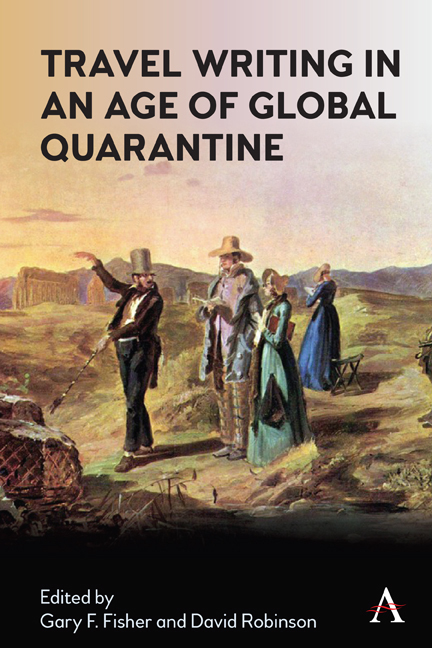Book contents
- Frontmatter
- Contents
- Foreword
- Acknowledgements
- Introduction
- Chapter One ‘Off-Stage, A War’: Wuhan, 1938
- Chapter Two Frederic Lees in Varese Ligure, 1911
- Chapter Three ‘A Rude People Subjected to No Restraint’: In Tanimbar with Anna Keith Forbes, Henry Forbes and So’u Melatunan
- Chapter Four Sent to Coventry: A Journey Home?
- Chapter Five Bedouin Is a Place: Freya Stark’s Travel with Nomads
- Chapter Six With Wilkie in the West: Reading Wilkie Collins’s Rambles beyond Railways from a Cornish Perspective
- Chapter Seven Picturing Rome: Walking the Eternal City with the Last Victorian
- Chapter Eight Su e zo per i ponti; or, How History Does Not Help
- Chapter Nine A Town Called Entropy: Boom and Bust in Arnold Bennett’s Potteries
- Chapter Ten Travelling towards Transculturalism? Statues, Remembrance and Mourning in Bloemfontein, South Africa
- Chapter Eleven Recollections of the King’s House
- Chapter Twelve Occupying Her Time: Ginette Eboué, France, 1940–42
- Epilogue
- List of Contributors
- Works Cited
Chapter Eight - Su e zo per i ponti; or, How History Does Not Help
Published online by Cambridge University Press: 18 November 2021
- Frontmatter
- Contents
- Foreword
- Acknowledgements
- Introduction
- Chapter One ‘Off-Stage, A War’: Wuhan, 1938
- Chapter Two Frederic Lees in Varese Ligure, 1911
- Chapter Three ‘A Rude People Subjected to No Restraint’: In Tanimbar with Anna Keith Forbes, Henry Forbes and So’u Melatunan
- Chapter Four Sent to Coventry: A Journey Home?
- Chapter Five Bedouin Is a Place: Freya Stark’s Travel with Nomads
- Chapter Six With Wilkie in the West: Reading Wilkie Collins’s Rambles beyond Railways from a Cornish Perspective
- Chapter Seven Picturing Rome: Walking the Eternal City with the Last Victorian
- Chapter Eight Su e zo per i ponti; or, How History Does Not Help
- Chapter Nine A Town Called Entropy: Boom and Bust in Arnold Bennett’s Potteries
- Chapter Ten Travelling towards Transculturalism? Statues, Remembrance and Mourning in Bloemfontein, South Africa
- Chapter Eleven Recollections of the King’s House
- Chapter Twelve Occupying Her Time: Ginette Eboué, France, 1940–42
- Epilogue
- List of Contributors
- Works Cited
Summary
For Feruccio Berolo, ballet dancer and ballet master, who loved Venice so much; my friend who was one of Venice's first victims of Covid-19.
It is a great pleasure to write the word; but I am not sure there is not a certain impudence in pretending to add anything to it. Venice has been painted and described many thousands of times, and of all the cities of the world is the easiest to visit without going there.
I am a historian of Venice. Since the mid-1980s, I have spent a lot of time in the Venetian state archives. In recent years I have barely crossed their threshold. I have stopped researching the city's past. I have, instead, spent a decade and a half researching what other historians said about Venice's past. Rarely does a day pass when I do not spend some time pondering what scholars wrote about the Republic of Saint Mark. Most of what they wrote is repetitive and dull. Historians spend a lot of time taking in each other's washing. They often launder it badly; sometimes they deliberately stain or tear it; sometimes they are just careless when it comes to folding. In the trade this is called historiography.
The Venetian Republic came to an end suddenly in 1797. Contrary to what many long-dead historians wrote, and a lot of living ones – unthinkingly and incorrectly – echo, the Most Serene Republic did not expire because of a century or so of decadence and decline. A myth persists that Venice's ruling elites had become effete and effeminate by the eighteenth century; that the men who ran Venice were either inflexible relics of a faded glory, or fops, addicted to coffee and gossip, the whorehouse and the gaming table. But repetition does not equate to fact. When Venice fell, it was a vigorous imperial power: to the west its territories stretched almost to Milan, encompassing the rich and populous mainland territories of the Po Valley; to the east, they reached deep into the Julian Alps, and down the Dalmatian Coast. In the 1790s, the winged lion still lurked, carved protectively into the walls of Adriatic ports; the Venetian gonfalone, the symbol of St Mark fluttered over the smattering of Greek islands that the Ottomans had never managed to seize.
- Type
- Chapter
- Information
- Travel Writing in an Age of Global Quarantine , pp. 107 - 118Publisher: Anthem PressPrint publication year: 2021



